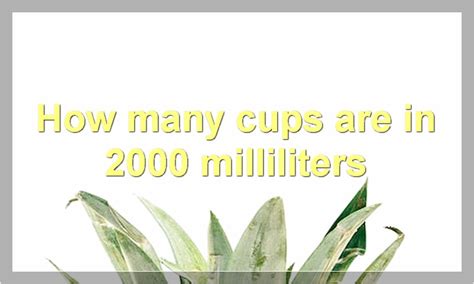How Many Cups Is 2000 Ml
Kalali
Apr 01, 2025 · 4 min read

Table of Contents
How Many Cups is 2000 ml? A Comprehensive Guide to Metric-Imperial Conversions
Converting between metric and imperial units can be confusing, especially when dealing with liquid measurements. Many recipes and instructions use cups, a common imperial unit, while others rely on milliliters (ml), a metric unit. Understanding how to convert between these units is crucial for accurate cooking, baking, and various other applications. This comprehensive guide will explore the conversion of 2000 ml to cups, delve into the intricacies of different cup sizes, and provide you with the tools to confidently navigate future conversions.
Understanding the Conversion Factor
The fundamental step in converting milliliters to cups is understanding the conversion factor. There isn't a single, universally accepted conversion because the size of a "cup" can vary. However, the most commonly used conversion factor is based on the US customary cup, which equals approximately 236.59 ml.
Therefore, to convert milliliters to US cups, you use the following formula:
Number of cups = Number of milliliters / 236.59 ml/cup
Using this formula, let's calculate how many cups are in 2000 ml:
2000 ml / 236.59 ml/cup ≈ 8.45 cups
So, 2000 ml is approximately equal to 8.45 US cups.
The Variability of Cup Sizes: Why Precision Matters
While 8.45 cups is a good approximation, the accuracy of this conversion depends heavily on the type of cup being used. The "cup" measurement isn't standardized across all countries and contexts. Here's a breakdown of the variations:
1. US Legal Cup:
The US legal cup is defined as exactly 240 ml. Using this definition:
2000 ml / 240 ml/cup = 8.33 cups
This is slightly less than the previous calculation, highlighting the importance of specifying the type of cup used.
2. UK Cup:
The UK cup is slightly smaller than the US cup, typically measuring around 284 ml. However, it also varies.
Using a standard UK Cup of 284ml:
2000ml / 284ml/cup = 7.04 cups (approximately)
This demonstrates a significant difference compared to the US cup measurement.
3. Metric Cup:
Some recipes might use a "metric cup," which is often defined as 250 ml.
2000ml / 250ml/cup = 8 cups
This is a more convenient and easily understood calculation, offering a whole number as the result.
Beyond the Basics: Factors Affecting Accuracy
Several factors influence the precision of the milliliter-to-cup conversion:
-
Liquid Type: The viscosity of the liquid can affect the accuracy of pouring measurements. Thicker liquids like honey or syrup will measure differently than water.
-
Measuring Tools: Using precise measuring tools like graduated cylinders or liquid measuring cups ensures more accurate results compared to using standard cups or mugs that aren't calibrated.
-
Pouring Technique: Even with accurate measuring tools, pouring technique can affect the amount of liquid dispensed. Consistent and steady pouring minimizes error.
-
Temperature: Temperature affects the volume of liquids; hot liquids expand, and cold liquids contract. This subtle change can become significant for large volumes.
Practical Applications: Cooking, Baking, and Beyond
Accurate conversions are critical in various applications:
Cooking:
Recipes often specify ingredients in cups. Converting from milliliters (often used in metric-based ingredient packaging) is essential to achieve the correct ratios and achieve consistent results.
Baking:
Baking is especially sensitive to ingredient ratios. Inaccurate conversions can lead to poor texture, inconsistent rise, or even failure of the baked good.
Science and Medicine:
Converting milliliters to cups is important in scientific experiments or medical applications that require precise liquid measurements.
Advanced Conversion Techniques: Working with Other Units
While we've focused on converting milliliters to cups, understanding other unit conversions can be beneficial:
-
Milliliters to Fluid Ounces: One US fluid ounce is equal to approximately 29.57 ml.
-
Milliliters to Tablespoons and Teaspoons: These smaller units are often used in recipes. Remember that there are 15 ml in a tablespoon and 5 ml in a teaspoon (approximately).
-
Using Online Converters: Numerous online converters are available that simplify the conversion process. However, always ensure the converter uses the correct definitions for cups.
Conclusion: Mastering Milliliters and Cups
Converting 2000 ml to cups isn't a simple one-size-fits-all answer. The variability of cup sizes demands careful consideration of the specific type of cup being used. This guide emphasizes the importance of precision in conversions and highlights the potential impact of various factors on the accuracy of your measurements. By understanding these nuances, you can confidently convert between milliliters and cups and achieve accurate and consistent results in cooking, baking, and other applications. Remember always to specify the type of cup you are using to avoid confusion and ensure accuracy in your measurements. Using precise measuring tools and careful techniques will always improve the accuracy of your conversions.
Latest Posts
Latest Posts
-
How Many Centimeters Is 23 Inches
Apr 02, 2025
-
How Many Gallons Is 10 Cups
Apr 02, 2025
-
What Is 62 Degrees Celsius In Fahrenheit
Apr 02, 2025
-
Is Usa In The Northern Hemisphere
Apr 02, 2025
-
How Many Glasses Is 32 Oz Of Water
Apr 02, 2025
Related Post
Thank you for visiting our website which covers about How Many Cups Is 2000 Ml . We hope the information provided has been useful to you. Feel free to contact us if you have any questions or need further assistance. See you next time and don't miss to bookmark.
